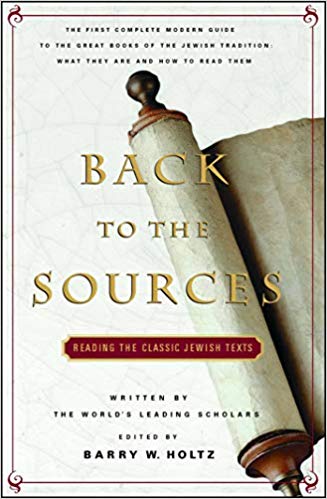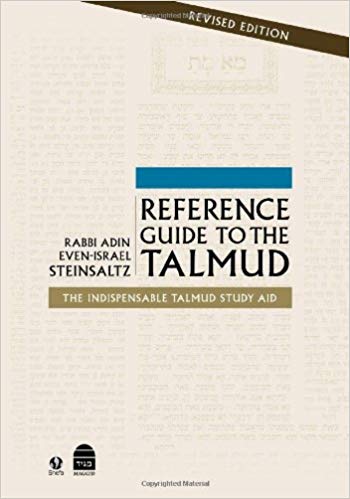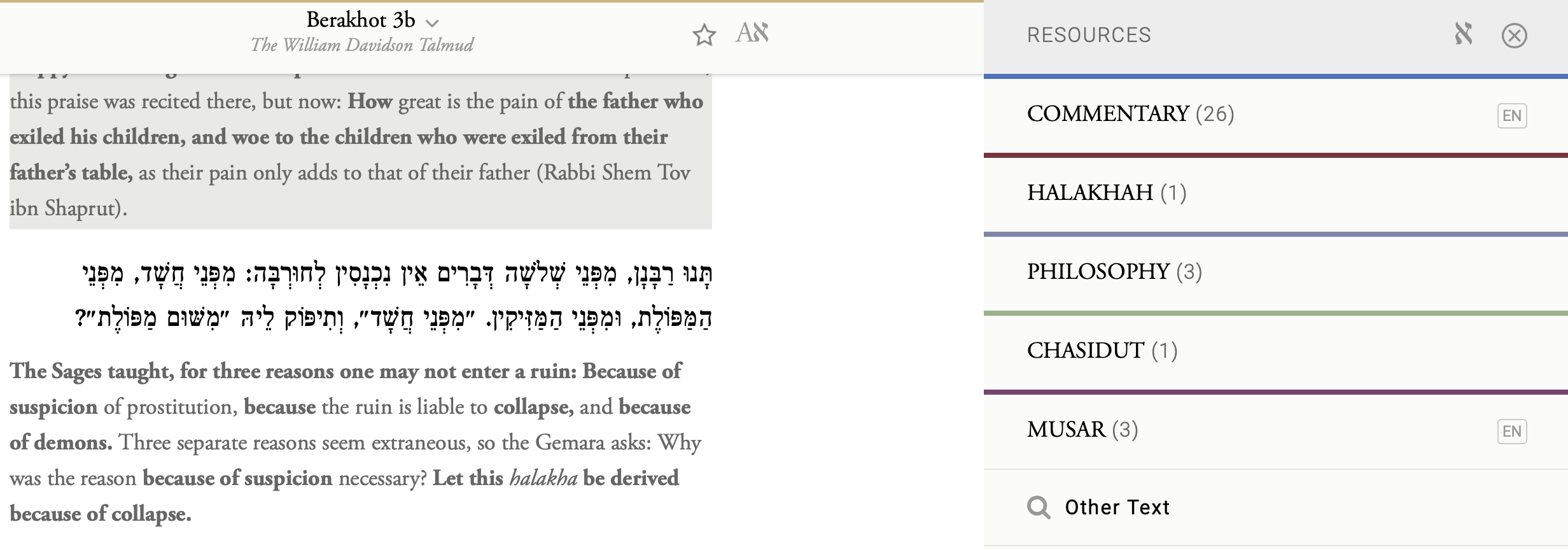If you’re new to learning Talmud, it can be a bit disorienting to just start reading. Whether you’re thinking of joining Daf Yomi (it’s not too late!) or just want to immerse yourself in some rabbinic wisdom, the Talmud is both the on-ramp, and can also be an incredibly challenging road-block for beginners: the narrative is meandering, it has unique methods of argumentation, and is filled with obscure and arcane terminology.
As Shulem Deen poetically notes:
We have to grapple with ways of thinking that are so far from our own, and still find the resonant chords; make sense of a logical system whose premises are archaic and confounding and dogmatic, but still see its elegance; imagine a world in which life’s mysteries and uncertainties are nearly unimaginable to our modern minds, and still see, in those who lived with them, the same human impulses as ours.
So on the one hand, you should feel empowered to pick up the Talmud and go – it’s our heritage, after all! On the other hand, you want to be primed to glean as much as you can.
Why not start by diving in with this quick article: How to participate in the longest-running Jewish book club (even if you can’t read Hebrew) – which answers questions like these:
- Do I need to be religious — or Jewish — to study Talmud?
- Can I study Talmud even if I have little or no Hebrew background?
- What version of the Talmud do you recommend I use, and where can I find it?
- What resources and study aides are most helpful?
- How do you keep track of everything you learn?
To get you started after that, here are some introductory and supportive materials that I’ve found to be helpful. I endorse them all. These all mostly assume that you’re starting Talmud study as a beginner, and reading the text in English translation. You don’t have to go in order, you can pick up an introductory book and listen to the podcasts together.
I. Where to Start?
1: Understanding The History of Jewish Texts and How They Work
 The Talmud is built upon an earlier text – the Mishnah – which itself is the early rabbis’ discussion on how to actualize the even earlier laws of the Torah. It’s hard to understand one without the other, so pick up the book Back to the Sources: Reading the Classic Jewish Texts, by Barry W. Holtz, which will help you out with the history, context, content, and methodology of these texts, and more.
The Talmud is built upon an earlier text – the Mishnah – which itself is the early rabbis’ discussion on how to actualize the even earlier laws of the Torah. It’s hard to understand one without the other, so pick up the book Back to the Sources: Reading the Classic Jewish Texts, by Barry W. Holtz, which will help you out with the history, context, content, and methodology of these texts, and more.
2: Who Were the Rabbis, and What did They Do?
 The Jewish Theological Seminary has a fantastic new short podcast series – The Evolution of Torah: A History of Rabbinic Literature. I highly recommend these five podcast episodes as a launching point for your journey into the Talmud. They are an easily-digestible, but comprehensive introduction that answer such questions as: What led to the emergence of the group of scholars and teachers we call the Rabbis? What motivated them and what did they value? How did the Babylonian Talmud become the most influential book in the Jewish world?
The Jewish Theological Seminary has a fantastic new short podcast series – The Evolution of Torah: A History of Rabbinic Literature. I highly recommend these five podcast episodes as a launching point for your journey into the Talmud. They are an easily-digestible, but comprehensive introduction that answer such questions as: What led to the emergence of the group of scholars and teachers we call the Rabbis? What motivated them and what did they value? How did the Babylonian Talmud become the most influential book in the Jewish world?
3: Dive Into the Sea of Rabbinic Literature
 If you’re ready to go deeper into how the Talmud itself functions, pick up the classic Introduction to the Talmud and Midrash, by Hermann L. Strack and Gunter Stemberger – it’s a dense, but good academic introduction to the Talmud. Stemberger discusses the historical framework, the basic principles of rabbinic literature and hermeneutics, and the most important Rabbis.
If you’re ready to go deeper into how the Talmud itself functions, pick up the classic Introduction to the Talmud and Midrash, by Hermann L. Strack and Gunter Stemberger – it’s a dense, but good academic introduction to the Talmud. Stemberger discusses the historical framework, the basic principles of rabbinic literature and hermeneutics, and the most important Rabbis.
4: Understand the Features of the Talmud
 This is still my go-to when I come across an obscure concept or argumentation theory. Rabbi Adin Steinsaltz’s Reference Guide to the Talmud is an indispensable resource for students of all levels. This edition is fully revised, and clearly and concisely explains the Talmud’s fundamental structure, concepts, terminology, assumptions, and inner logic. It provides essential historical and biographical information, and includes appendixes, a key to abbreviations, and a comprehensive index.
This is still my go-to when I come across an obscure concept or argumentation theory. Rabbi Adin Steinsaltz’s Reference Guide to the Talmud is an indispensable resource for students of all levels. This edition is fully revised, and clearly and concisely explains the Talmud’s fundamental structure, concepts, terminology, assumptions, and inner logic. It provides essential historical and biographical information, and includes appendixes, a key to abbreviations, and a comprehensive index.
5: Looking for Something More Personal?
 Barry Scott Wimpheimer’s new The Talmud: A Biography provides “a concise biography of this quintessential work of rabbinic Judaism [that] takes readers form the Talmud’s prehistory in biblical and second-temple Judaism to its present-day use as a source of religious ideology… He describes the books origins and structure, its centrality to Jewish law, its mixed reception history, and its golden renaissance in modernity.” (from the book jacket). I found the book to be a bit overly-technical in its approach to dissecting the Talmud, but it’s a great, shorter introductory text that also introduces readers to a lot of other contemporary literature on the Talmud.
Barry Scott Wimpheimer’s new The Talmud: A Biography provides “a concise biography of this quintessential work of rabbinic Judaism [that] takes readers form the Talmud’s prehistory in biblical and second-temple Judaism to its present-day use as a source of religious ideology… He describes the books origins and structure, its centrality to Jewish law, its mixed reception history, and its golden renaissance in modernity.” (from the book jacket). I found the book to be a bit overly-technical in its approach to dissecting the Talmud, but it’s a great, shorter introductory text that also introduces readers to a lot of other contemporary literature on the Talmud.
6: Want an Online Class?
Coursera has a 4-session online course run in partnership with Northwestern University – The Talmud: A Methodological Introduction. It’s taught by Barry Wimpheimer (author of The Talmud: A Biography), and this would be a natural way to continue some of your learning.
II. Read the Talmud!
Which Edition?
 If you’re planning to study in English, there are a few translations available, but I don’t think you can do any better than the recently-completed Koren Noé edition, which is based on Rabbi Adin Steinsaltz’s monumental Hebrew edition of the Bavli. You can get it in print individually by masekhet (tractate/volume), or as a complete series (it will set you back a pretty penny, but it’s a beautiful addition to any Jewish library).
If you’re planning to study in English, there are a few translations available, but I don’t think you can do any better than the recently-completed Koren Noé edition, which is based on Rabbi Adin Steinsaltz’s monumental Hebrew edition of the Bavli. You can get it in print individually by masekhet (tractate/volume), or as a complete series (it will set you back a pretty penny, but it’s a beautiful addition to any Jewish library).
The other leading English option available is from Artscroll, but I don’t think it compares to the Koren in terms of accessibility, commentary, user-friendly design, and scholarship. There’s an ongoing “Artscroll vs. Koren” debate, but in my opinion, it’s been handily won (perhaps not yet in sales, but certainly in beauty, grandeur, and integrity) by Koren.
Head’s up: in the Koren Noé / Steinsaltz editions, the Hebrew/Aramaic and English text is broken up and punctuated into into smaller chunks by argumentative unit. This is different from a standard print edition of the Talmud that doesn’t have similar punctuation or section breaks, but it makes it much easier to follow the internal logic.
Print or Digital?
I don’t think you can compare studying the text with a book in your hand to using a screen – there’s something about the traditional way of encountering the text on the page, with all the marginalia, centuries of added wisdom, and the ability to add your own notes in as you go. But, hey, it’s 2020! If you’re not up to shelling out $1,000, Koren also offers the ability to purchase PDFs of the same beautiful printed text.
Thanks to Sefaria (an online library of Jewish texts and easily my most-used website/app as a rabbi), the entire Koren English translation of the Talmud is available online for free. Don’t underestimate the significance of this fact – it’s truly a momentous landmark in the entire history of Jewish education. Don’t take my word for it, check out what The Washington Post had to say.
Using Sefaria
A few helpful notes on using Sefaria to study Talmud:
You can find the text of the Talmud here. Or, if you’re doing Daf Yomi, you can scroll down on the main page and link directly to today’s daf:
The text appears differently than in a standard printed Talmud – rather than laid out page by page, you’re going to get a continual stream of the text, with subheadings telling you when you cross a corresponding printed page.
Like the Koren English print edition, the Hebrew/English text on Sefaria is broken up into smaller chunks by argumentative unit. The bold text is the literal/idiomatic translation of the Aramaic/Hebrew, while the unbolded text rounds out the sentences with additional context and commentary from Rabbi Adin Steinsaltz. Aramaic is notoriously terse, so these additions are very helpful.
Most importantly, if you click on the text itself, you’ll bring up the Resources menu, where you can find links to later commentaries and other texts that make use of the passage:

Other helpful hints: if you click the title of the daf (e.g. Bereakhot 3a in the screenshot below), you can jump to other pages throughout the Talmud. If you click the small Aא in the top right, you can change the layout and display options.
III. Daf Yomi Podcasts
These are my two go-to podcasts for catching up on Daf Yomi and adding to my own learning, but there are dozens out there. Just know that you’re almost always getting the Gemara filtered through a particular religious worldview – so do your research and choose wisely! Download these ones on iTunes, or your favourite podcasting app (I’m a big fan of Castro and Overcast).
 5-Minute Daf Yomi with Rabbi Shmuel Herzfeld
5-Minute Daf Yomi with Rabbi Shmuel Herzfeld
Rabbi Herzfeld does a great job of distilling the ikar – the central ideas of each daf – into a 5-minute podcast. He asks a few bigger thematic questions, so we can grapple with the relevance of what we’ve just learned. You also get to hear his reading and translating of the talmudic text in the traditional lyrical, almost song-like way of helping memorize the words. While there’s a lot of jargon and insider language (legal terminology, names, later commentaries) in this podcast, it’s easily digestible, and if you’re okay with looking up any concepts you want to know more about, this is a great way to keep up with the pace.
Daf Yomi for Women (Not just for women!) From Michelle Cohen Farber and Hadran, the only organization dedicated exclusively to inspiring and enabling Jewish women across the world to learn Talmud. You can read about them in this great New York Times profile on the women-driven revolution in education. This is a longer podcast (usually ~45 minutes), quite fast-paced, that goes more in depth into each daf. If you have the time, and are also willing to look up any new concepts that aren’t defined, it’s a great way to hear the voices around the table. The first episode for this cycle also includes a great introduction to the Talmud, and is a good place for beginners to start.
From Michelle Cohen Farber and Hadran, the only organization dedicated exclusively to inspiring and enabling Jewish women across the world to learn Talmud. You can read about them in this great New York Times profile on the women-driven revolution in education. This is a longer podcast (usually ~45 minutes), quite fast-paced, that goes more in depth into each daf. If you have the time, and are also willing to look up any new concepts that aren’t defined, it’s a great way to hear the voices around the table. The first episode for this cycle also includes a great introduction to the Talmud, and is a good place for beginners to start.
IV. What’s Next?
Check out my own Instagram account Daily Talmud (shameless plug!), dedicated to Daf Yomi and follow along with the wisdom of the Talmud.
We are blessed that this is the golden age of new books and learning about the Talmud’s place in our lives – both spiritual and academic. Here are just a few of my favourites that are good for beginners:
Author and NYU Professor Jeffrey Rubenstein has a number of books teaching about the amazing stories (aggadah) from the Talmud. Two ones I wholeheartedly recommend are: The Land of Truth: Talmud Tales, Timeless Teachings and Stories of the Babylonian Talmud.
Rabbi Benay Lappe’s TedX and ELI talks on how “every religion comes into being to create meaning, and meaning comes by way of a “master story,” like Torah. But every master story will eventually…crash.” Rabbi Lappe’s wisdom here provides a great entry point into understanding how it was that something like the Talmud could even come into being.
If All the Seas Were Ink: This is a really beautiful memoir written by Ilana Kurshan, who tracks her experience of doing daf yomi, exactly as she was going through a divorce and thought her life was falling apart. From the introduction: “A deeply accessible and personal guided tour of the Talmud, shedding new light on its stories and offering insights into its arguments―both for those already familiar with the text and for those who have never encountered it.
In his text, Tradition and the Formation of the Talmud, Moulie Vidas suggests that the redactors of the Babylonian Talmud had an overarching message that they desperately wanted to convey. He probes the multivalent text to search for what it is that they urgently wanted us to feel. A beautiful and penetrating academic, yet spiritual, search into the text.
Shulem Deen’s Why Talmud is the Way To Be Jewish Without Judaism offers a provocative and intimate look into the experience of studying Talmud every day. One salient piece of advice Deen has bestowed upon me is to be weary of the liberal tendency to “reduce the vast body of our traditional literature to proverbs and aphorisms unearthed from deep within, so deep that their context is often unknown, their original meanings replaced with a vapid overlay of modern sensibilities, fashionably recasting ancient rabbis…” As Deen notes, “We do this with good intentions,” but “with profound ignorance.” It’s a humility-inspiring text.
The Talmud of Relationships, Volume 1 & 2: Enter the Talmudic study house with innovative teacher Rabbi Amy Scheinerman and continue the Jewish values – based conversations that began two thousand years ago. The Talmud of Relationships, shows how the ancient Jewish texts of Talmud can facilitate modern relationship-building, asking such question as: How can I tame my ego? How might I control my anger? How might I experience the spirituality of sexual intimacy? How can I bestow appropriate honor on a difficult parent? How might I accept my own suffering and the suffering of those whom I love? How can I lead others with authority and kindness? How can I strengthen my self-control? How can I balance work and family? How can I get along with difficult coworkers? How can I best relate to people in need? (From the Publisher)


